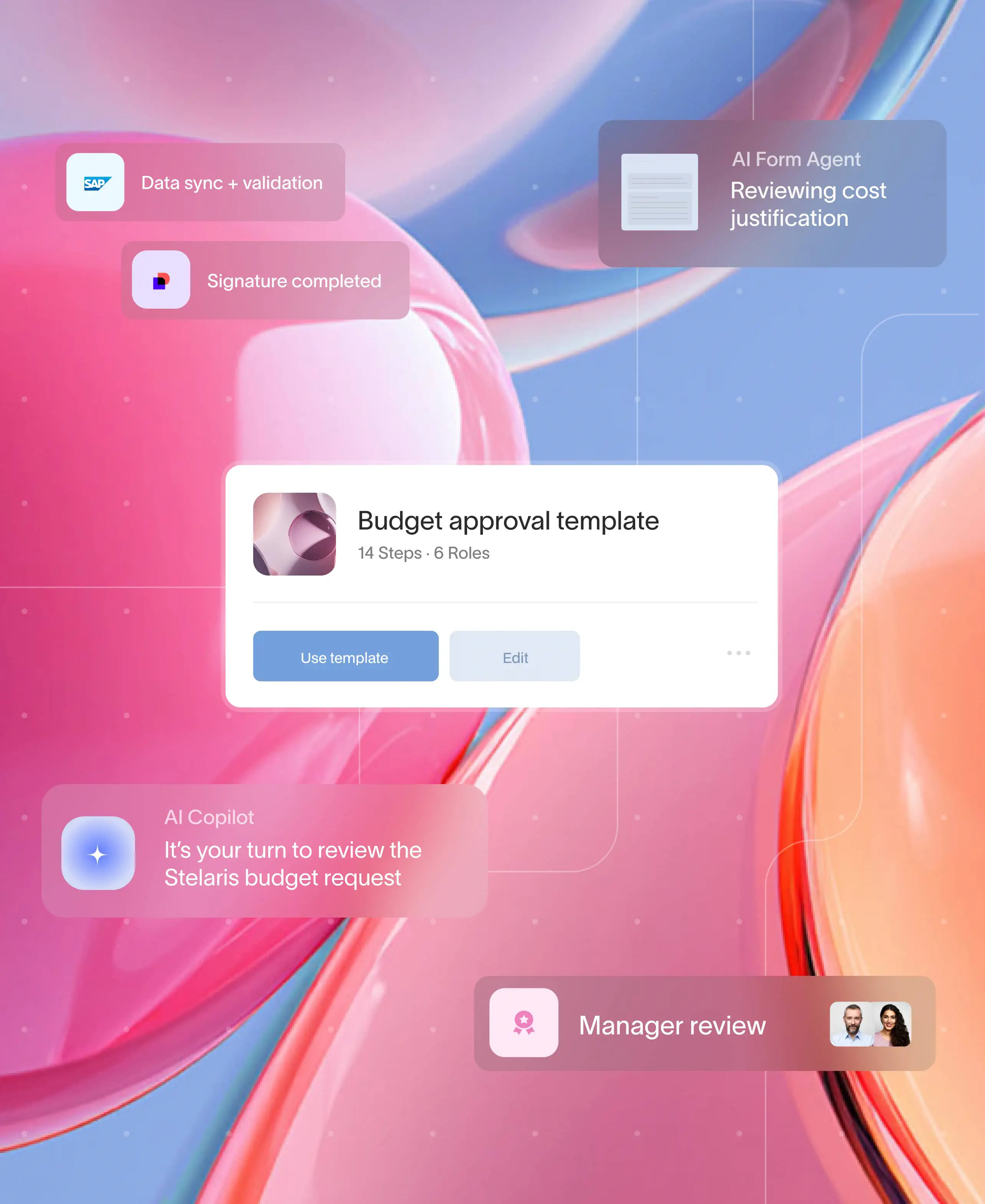
At a glance
Document portal software centralizes secure file sharing, collaboration, and approvals in one place.
Unlike simple file-sharing links, a secure document portal adds compliance, audit trails, and structured workflows.
Businesses use client document portals to reduce delays, cut email clutter, and keep exchanges audit-ready.
Moxo customers like BNP Paribas have cut onboarding time by 50% by digitizing document exchange and approvals.
Why documents matter more than distribution
Information exchange underpins every client engagement, transaction, and project. Yet in most organizations, documents still move through email threads or shared drives that lack structure, version control, or accountability. This introduces risk: teams waste time reconciling versions, compliance audits are delayed, and clients experience friction.
A secure client document portal is designed to eliminate these gaps. It centralizes submission, review, approval, and signature processes into one controlled environment. Rather than scattering files across tools, the portal maintains a single source of truth for every stakeholder. This article explores how document portals differ from file sharing and document management systems, why they matter, and the contexts in which they deliver the most value.
Where document portals deliver the greatest impact
The exchange of documents defines critical moments in every client relationship. A misplaced file, a delayed approval, or a compliance oversight can slow down entire projects and erode trust. Document portals address these challenges by consolidating all exchanges into a secure and structured environment.
In financial services, secure document portal software supports know your customer (KYC) requirements and compliance-driven onboarding. Consulting firms rely on document upload portals to streamline multi-party due diligence and contract validation. Real estate organizations accelerate contract execution and client handoffs by keeping disclosures, approvals, and signatures in a centralized space. Marketing agencies reduce client churn and feedback delays by managing creative reviews and approvals within a single document exchange portal.
Any organization that depends on accuracy, compliance, and speed in client or partner interactions gains measurable value from a client document portal. The software provides more than convenience: it establishes the infrastructure for consistent, audit-ready operations.
Document portals vs file sharing vs document management systems
A document portal is a dedicated environment for securely exchanging, reviewing, and approving files between organizations and their external stakeholders. Unlike internal repositories, a document portal is client-facing by design. It provides clients, partners, or vendors with a branded and structured space to upload, access, and act on documents while maintaining visibility and control for the organization managing the portal.
File sharing, by contrast, is transactional. A shared drive link or email attachment moves a file from one person to another without establishing a process around it. While convenient, file sharing lacks the guardrails required for compliance, version control, and accountability. For organizations that must prove the chain of custody or maintain an audit trail, simple file sharing creates risk rather than reducing it.
Document management systems (DMS) solve a different problem. They serve as internal repositories, helping teams organize, search, and retain documents within the enterprise. A DMS ensures that knowledge assets are stored and retrievable. However, it is not designed for client-facing workflows. When organizations try to stretch a DMS into an external role, they often encounter adoption issues, access restrictions, and security concerns.
A secure client document portal bridges this gap. It combines the structured control of a DMS with the accessibility of file sharing but layers on compliance features, audit trails, and workflow automation. The result is a system designed not only to store documents but to move them through the critical processes that define business relationships.
Core use cases for document portals
The value of a document portal becomes most visible when organizations face complex, high-stakes exchanges that cannot rely on email or consumer-grade file sharing. In financial services, portals streamline onboarding and ongoing compliance by centralizing document requests, submissions, and approvals. Clients upload sensitive information through a secure document upload portal, while institutions maintain a complete audit trail for regulators.
In consulting and professional services, project success often depends on gathering proposals, NDAs, or due diligence files from multiple stakeholders. A document exchange portal reduces delays by assigning clear submission paths, tracking progress, and automating reminders. This structure removes the manual follow-up that consultants typically spend hours managing.
Real estate transactions illustrate another critical application. Agents, buyers, and sellers must sign and exchange contracts under tight deadlines. A client document portal accelerates this process by keeping disclosures, contracts, and signatures in one secure space accessible from any device. The result is faster closing times and fewer missed opportunities.
Agencies and creative firms also benefit. Campaign approvals, asset reviews, and version control create bottlenecks when spread across links, attachments, and chat threads. By channeling feedback and approvals through a document sharing portal, agencies shorten feedback loops and strengthen client trust.
Across these industries, the underlying theme is the same. A secure document portal transforms document management from a passive repository into an active part of business execution. It provides the infrastructure for collaboration, compliance, and speed, ensuring that documents move as efficiently as the work they represent.
The essential features of document portal software
A secure document portal is more than a place to exchange files. Its value lies in the features that transform document exchange into a structured, auditable process. At the foundation is secure file transfer with encryption in transit and at rest, combined with role-based permissions that determine who can view, edit, or approve specific documents. This ensures that sensitive material does not circulate outside controlled boundaries.
Audit trails are another essential element. Every upload, download, approval, or annotation is recorded to provide accountability and compliance transparency. For industries such as financial services and legal, this functionality is not optional. It allows organizations to demonstrate adherence to regulatory requirements and eliminates the risk of undocumented actions.
Version control also plays a defining role. Rather than scattering multiple drafts across emails or shared drives, a document portal maintains a single authoritative version while preserving access to the history of changes. This removes confusion and establishes clarity around what constitutes the final, approved document.
Workflow automation extends these capabilities by structuring the movement of documents. Approval chains, conditional routing, and automated notifications ensure that files progress through the right sequence of stakeholders without manual intervention. This orchestration prevents bottlenecks and reduces the reliance on follow-up emails.
Finally, a document portal must be accessible across devices and adaptable to the brand identity of the organization. White-labeled portals with mobile access allow clients and partners to engage seamlessly, whether on desktop or smartphone. Adoption increases when the experience feels professional, secure, and aligned with the organization’s broader digital strategy.
Collectively, these features define the difference between a basic file transfer tool and a client document portal. They enable organizations to replace fragmented exchanges with an integrated system for collaboration, compliance, and execution.
Moxo’s role in secure document portals
The objective of a document portal is not only to exchange files but to orchestrate the workflows that depend on them. Moxo was built to achieve this by providing a secure, structured environment where documents, tasks, and approvals move forward without delay.
Security is foundational. Moxo’s document portal software incorporates encryption, granular role-based permissions, and complete audit trails. Every upload, annotation, or electronic signature is recorded, ensuring compliance standards are met. This is why financial institutions such as BNP Paribas reported a 50 percent reduction in onboarding time after migrating client document submissions and approvals into a Moxo-powered portal. The result was accelerated client activation, greater operational efficiency, and improved compliance visibility.
In professional services, Moxo enables multi-party collaboration on sensitive files. Sherwood Partners streamlined their M&A due diligence by automating document requests, approvals, and reminders within Moxo. What previously required weeks of coordination over email was reduced to days in a centralized document exchange portal.
Flexibility is another defining element. Organizations can fully white-label Moxo’s portal, aligning it with their brand identity while providing clients with a seamless mobile and web experience. Agencies such as Webware have leveraged this to increase client capacity by managing campaign approvals and asset reviews within their secure document portal, avoiding the inefficiencies of scattered email feedback.
By unifying secure document exchange with workflow automation, Moxo transforms document management into an operational advantage. It functions not merely as a document sharing portal but as an end-to-end client engagement hub that reduces delays, strengthens compliance, and sustains trust.
Conclusion
Document portals represent a strategic requirement for organizations that must handle sensitive information, meet compliance standards, and accelerate decision-making across client and partner interactions. Unlike file-sharing tools or document management systems, a secure document portal creates a structured environment where documents, approvals, and workflows progress seamlessly.
Organizations across financial services, consulting, real estate, and marketing are already demonstrating measurable gains in efficiency and client satisfaction through document portal adoption. The lesson is clear: when document exchange becomes structured, audit-ready, and automated, business moves faster and trust deepens.
To see how Moxo delivers secure, audit-ready document portals that accelerate execution and strengthen client trust, book a demo today.
FAQs
Can a document portal integrate with existing systems?
Yes. Document portal software such as Moxo connects to CRMs, ERPs, and document management systems through APIs, webhooks, and native integrations. This ensures client files, approvals, and status updates remain synchronized without manual uploads. Many organizations start by linking Salesforce or HubSpot with a secure document portal, keeping client records and document workflows aligned.
How secure is a client document portal?
A secure document portal protects files with encryption in transit and at rest, granular permissions, and full audit trails. Moxo enhances this with role-based access controls and automated logging of every action. Financial institutions rely on this level of security to meet know your customer (KYC) and compliance requirements while reducing the risks of email-based file exchange.
Why not rely on email or shared drives for document exchange?
Email and shared drives lack structure, accountability, and compliance features. A document exchange portal consolidates uploads, approvals, annotations, and e-signatures into a single process with full audit trails. This reduces errors, accelerates cycle times, and provides transparency. BNP Paribas, for example, cut onboarding time by 50 percent after replacing email document exchange with a secure client portal.
How long does it take to implement document portal software?
Implementation is typically measured in weeks, not months. Simple use cases like document collection and approvals can be launched in days using templates. More complex workflows that involve multi-party reviews or custom routing expand over time.





